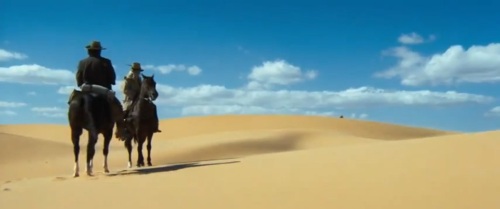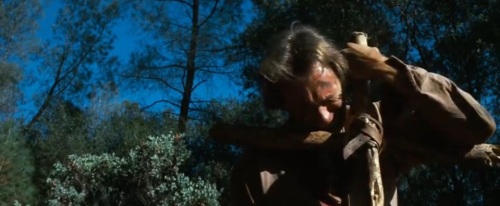
Two renowned westerns hit American movie screens in the bicentennial summer of 1976: Don Siegel’s funereal vehicle The Shootist, starring John Wayne in his final role as J.B. Books, a famed gunslinger taking up short-term residence in Carson City, Nevada after being diagnosed with terminal cancer (of which Wayne also was suffering, and would succumb to only a short time later); and The Outlaw Josey Wales, Clint Eastwood’s second outing as a western director (after his 1973 hit, the ghostly High Plains Drifter, and nearly two decades after his establishment as a genre icon portraying Rowdy Yates in TV‘s Rawhide and–most importantly–his career-defining Man with No Name in Sergio Leone‘s 60s trilogy).
Closely grouped together as they were, with Wayne’s film oozing finality and Eastwood’s heralding a character with newly-minted legend status (and with both films‘ leads being relentlessly hunted by nasty grubs looking to cash in on their heads), it’s easy to see the relationship between the two films as a sort of passing of the torch. The Shootist still feels like a more traditional oater, brightly lit and studded with roles for old Hollywood stars like James Stewart, Richard Boone, Lauren Bacall and Henry Morgan. The Outlaw Josey Wales, meanwhile, is foreboding and dark (being shot by that Prince of Darkness Bruce Surtees), while also featuring a supreme array of 70s character actors. Josey Wales also feels like it’s staking new claims on behalf of two constituents that usually didn’t get their fair due in westerns: Native Americans and women.

Eastwood’s film has a curious background. First and chiefly, it was based on a book by Forrest Carter. Published in 1975 under the title The Rebel Outlaw: Josey Wales (and quickly retitled Gone to Texas), the manuscript was initially delivered anonymously to the publishing company in the early 70s. When Carter’s identity was finally “revealed,” the seeds of a controversy took root: the NY Times discovered the author‘s return address matched up with Asa Carter, the segregationist and former KKK member who’d worked for Alabama governor George Wallace and has recently run for governor of that state. Carter wrote a sequel, The Vengeance Trail of Josey Wales, in 1976. But it was his third novel, The Education of Little Tree, also from 1976, that really helped uncover his past. Little Tree was a novel of tolerance, telling the story of a Cherokee boy with a Scottish-Cherokee grandfather (also named Wales) who teaches the boy the ways of the tribe.
The book really didn’t take off until a decade after Carter’s 1979 death, when it started hitting the #1 spot on the best sellers lists, winning book awards and, eventually, getting a massive stamp of approval when Oprah Winfrey recommended it to rabid viewers of her daily TV show. Its success solidified, media curiosity insured that Carter’s racist past would finally come out into the open (though it was denied by Carter’s widow). Oprah was forced to backtrack her opinions of Little Tree, which was seen by some in the Cherokee community as being rather stereotypical and factually specious. What else could she do, given that its author–like fictional character Forrest Gump– had taken his new first name from Confederate Civil War general Nathan Bedford Forrest?
The Outlaw Josey Wales, as a film, had a rocky history, too. Phillip Kaufman, then recently the writer/director of another mildly acclaimed Western, 1972’s Jesse James-driven The Great Northfield Minnesota Raid, had been contracted to direct Eastwood and to adapt Carter’s book (neither had any inkling of the author’s past). Working with Sonia Chernus and an unaccredited Michael Cimino, Kaufman delivered what Eastwood agreed was an exciting script that cleaved closely to the original novel. But on-set clashes over the pains Kaufman was taking on each shot revealed a rift (Eastwood is still considered one of the most time-efficient filmmakers out there). Also, Kaufman didn’t approve of Sondra Locke, whom Eastwood had cast in Josey Wales after beginning an affair with her that would continue for a decade before revealing its own schisms. And so, after a month of filming, and against the objections of the Director’s Guild (who imposed a punitive fine on the production and instituted said fine as “The Clint Eastwood Rule”), Eastwood took drastic measures to unseat Kaufman and take over the directing duties himself. With Kaufman’s adept preparations, the rest of the film’s vast, location-rich production went smoothly.

Seen today, The Outlaw Josey Wales preserves its power to entertain, as well as the dichotomous emotions of the source book’s author. It’s unrelentingly brutal from the get-go, as Missouri farmer Wales sees his wife and son being murdered by Union soldiers while their home is burnt to the ground (this chaos is led by perennial 70s bad guy Bill McKinney). Basically a tale of vengeance (and one without the deep subtexts of Eastwood’s later and slightly better Unforgiven), the film continues to document the oppression of the Confederates in the light of their war’s loss (there’s a particularly bloody scene early on that has Confederates being Gatling-gunned en masse by Union soldiers who’ve just obtained their allegiance and surrender). All throughout, especially if you know the background of the novel’s author, the viewer begins to notice a conflict in its worldview: yes, this is a movie about a man aligned with the damned Confederates and with no qualms over killing–but he’s actually a middle-grounder with no real skin in the Civil War and who only becomes anti-Union when his family is taken from him.
He’s also someone who’s ready to side with those who’ve been cast off–mainly, the Indians (at an isolated supplies post, Wales saves a talky Navajo squaw from a pair of fur-bearing outlaws) and, later in the film, a family of beset-upon women on the outskirts of a forgotten township peopled with abandoned losers. Wales’ sense of trust is also tough and reliable: he casts a suspicious eye to all, but is also unerring when his suspicions have proven unfounded, and only then he is unshakably loyal. After dispatching a group of Union soldiers out for his blood, Wales and his Cherokee friend Lone Watie are riding into Texas as they talk:
Lone Watie: I guess we ain’t gonna see that little Navajo girl again.
Wales: I guess not. I kinda liked her. But then it’s always like that…
Lone Watie: Like what?
Wales: After I get to likin’ someone, they ain’t around long.
Lone Watie: I noticed when you get to dislikin’ someone, they ain’t around long neither. (Wales barely regards this observation) How did you know who was gonna shoot first?
Wales: Well, that one in the center, he had a flap holster, and he was in no itchin’ hurry. And the one second from the left–he had scared eyes. He wasn’t gonna do nothin’. But that one of the far left–he had crazy eyes. Figured him to make the first move…
Lone Watie: How ‘bout the one on the right?
Wales: Never paid him no mind. You were there.
Lone Watie: (after a long pause) I could have missed.
A large portion of The Outlaw Josey Wales’ appeal, for me at least, has to do with the vibrant relationship between these two characters. It’s filled with frank (and often humorous) talk about history, truth, violence, and nature. Eastwood is splendid in the lead, but Chief Dan George dutifully steals every scene he’s in. It’s a meaty supporting performance that requires much physicality and cleverness from this Canadian-born Burrard Band chief who didn’t begin acting until his early 60s. By the time Josey Wales was in production, he was 76 years old; though he had garnered a Supporting Actor Oscar nomination in 1970 for his memorable turn in Arthur Penn’s Little Big Man, I still look at his performance in Eastwood’s film as his most notable and substantial. I love it when, gun pulled and pointed, he’s boasting to Wales about his sneakiness, only to be ambushed by the Navajo woman (Geraldine Keams); equally great is when Wales catches them together in the sack, with Lone Watie proudly remarking “I guess I’m not as old as I thought I was.” He’s marvelous here.

The film (well-edited by Ferris Webster) never loses steam. It presses on, through the Missouri countryside, into the Texas dunes, and doesn’t even let up once Lone Watie and the tobacco-spittin’ Wales encounter a home they can perhaps adopt: an adobe domicile headed by a straight-talking, good-with-a-gun grandma (Paula Trueman) and her meek granddaughter (Locke). Even there, with the Union soldiers (led by an unusually reluctant John Vernon) at their backs, and threats from local Indian tribes, this new band of brothers and sisters show their mettle in surprising ways (another scene I adore has Wales wisely negotiating peace with a stoic Indian chief ready for battle; in true 70s fashion, the chief is played by One Flew Over the Cuckoo’s Nest veteran Will Sampson). I’ve never been a fan of Sondra Locke–though I do love her in her debut film The Heart is a Lonely Hunter–but, otherwise, I’ve always found her a little too wild-eyed and neurotic. She’s good here, though, particularly in one very snappy love scene with Eastwood, in which she catchily explains the meaning of the Missouri state motto “Show me” (which Wales adeptly turns back around on her).
I like how the film doesn’t fall astern into old ways of doing things. The Indians are smart and largely peaceful; the women aren’t shrinking violets; the Union soldiers are not heroic, and the Confederates are not scum. The barbarism of the West is mixed with a more liberal brand of acceptance, without seeming mealy-mouthed or unrealistic. The dialogue is consistently fine, Surtees’ widescreen photography is at once at his typical inkiness and yet also screams with blinding sunlight when necessary, and Jerry Fielding’s score pops in all the right places (particularly in its fife-based main theme, which sounds so authentic it seems impossible it‘s a piece written for the movie–Fielding ended up getting the film’s only Oscar nomination, though I definitely think Josey Wales deserved nods at least for the Kaufman/Chernus script and for Chief Dan George).
I also revel in the wide array of often beady-eyed, Western-flavored character actors on display here–Vernon, Sampson, Trueman, McKinney (despicable), Sam Bottoms as a doomed young Confederate, Woodrow Parfrey as a white-suited snake-oil salesman, Charles Tyner as the vicious owner of the supply shed, and Sheb Wooley, Matt Clark, Joyce Jameson and Royal Dano, to boot (even longtime stuntman and actor Richard Farnsworth is seen for a second). Come to think of it, as this film hit theaters around the time the Western was dying in Hollywood–just as John Wayne was dying–The Outlaw Josey Wales might have been the last movie to gather such a gallery of recognizable performers in these sorts of roles. Let’s face it: were it not for Eastwood’s efforts–of which Josey Wales is one of the crown jewels–the western genre would’ve gone underground a long time before it largely did.

No comments:
Post a Comment